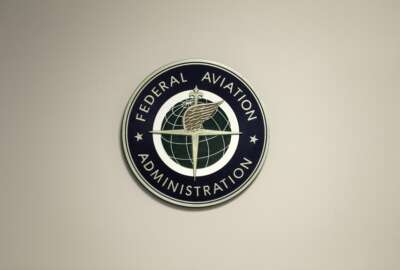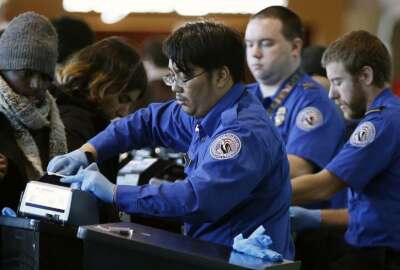Hubbard Radio Washington DC, LLC. All rights reserved. This website is not intended for users located within the European Economic Area.
VA touts its largest nursing workforce, but union says they’re ‘chronically understaffed’
The VA employs the largest nursing workforce in the country. But a nurses union says VA is leaving positions unfilled, spreading VA nurses thin.
Nurses at the Department of Veterans Affairs are calling on leadership to hire more frontline health care workers, and protesting nationwide staffing shortages that they say make it harder to treat veterans.
VA nurses represented by National Nurses Organizing Committee (NNOC) and National Nurses United (NNU) rallied outside the VA’s headquarters in downtown Washington, D.C. on Thursday.
NNOC/NNU are calling on the VA to lift “what is, in effect, a hiring freeze,” that has led to 66,000 vacancies across the VA health care system. More than 13,000 of those vacancies are nursing positions.
The Veterans Health Administration hired 61,000 employees last year, its fastest rate of growth in 15 years, and saw its total workforce peak at more than 400,000 employees — its highest-ever headcount.
But the VA has scaled back its health care hiring goals this year, and is planning to cut its workforce by 10,000 positions, under its fiscal 2025 budget proposal. Most of the job cuts would come from VHA.
VA Secretary Denis McDonough told reporters the department expects to manage this reduction through attrition.
VA leaders have repeatedly said VHA isn’t going through a hiring freeze, and that it continues to hire for frontline medical positions — just at a less aggressive pace than it did last year. because of higher employee retention rates.

NNU Vice President and Veterans Affairs Chairwoman Irma Westmoreland, a registered nurse at the Charlie Norwood VA Medical Center in Augusta, Georgia, said VA nurses are spread thin by unfilled positions, leading to burnout and “moral distress.”
“We feel the lack of these nurses in our faculties every day — every single day,” Westmoreland said in an interview. “We feel that we are chronically understaffed in nursing, and that is erodes the patient care that we’re able to provide for our veterans. And this hiring freeze cuts services to veterans.”
VA Press Secretary Terrence Hayes said in a statement that “there is no nationwide hiring freeze on VA nurses,” and that over the past three years, the VA increased its nursing workforce by 14,000 positions.
Hayes said the VA currently employs 122,000 total nurses — the largest nursing workforce in the country and in the history of VA. VA’s nursing workforce, he added, has a turnover rate of 3.4%, and is “far outperforming” the private sector.
The VA, he said, has increased staffing by more than 3% so far in fiscal 2024.
“There is no shortage of VA staff. After a record year of hiring in 2023, VA currently has the largest health care workforce in our history — and we are retaining those great employees at all-time record rates,” Hayes said.
Jordan Le Blanc, an ICU nurse at the Rocky Mountain Regional VA Medical Center in Aurora, Colorado, said VA’s “gold standard” for care is to have an ICU nurse assigned to care for one or two critically ill patients.
Since December 2020, however, Le Blanc said ICU nurses in his facility have been following a “crisis nursing” staffing model, and are assigned three patients.
“It has already diminished the quantity of the services that we can provide, and it really at the individual level of each interaction that I have with veterans,” LeBlanc said, speaking in his capacity as an NNU member. “It poses a risk that diminishes the VA mission and the way that we should be honoring these individuals for the service that they provided to our country.”
Le Blanc said his VA medical center will, at times, assign nurses to cover the ICU, but who don’t have ICU specialty training.
“They do not know how to manage mechanical ventilators or medications that augment blood pressure that are infused continuously. And so, that ultimately means that the quality of care — really the dignity of care, at the simplest level — is impacted in a negative way,” he said.
A VA inspector general report in August 2023 found 93% of VA medical facilities reported a severe staffing shortage of practical nurses.
McDonough told reporters in April that VA’s nurse-to-patient ratios are not “perfect in every facility,” but said nurses are generally spread thinner in private health care facilities.
“The stress that comes with an individual nurse covering multiple beds in an ICU, for example, in a community, is not matched to the VA system, where our patient ratios suggest that it’s a much different experience,” McDonough said.
Chief Financial Officer Jon Rychalski told reporters in March that the MISSION Act, COVID-19 pandemic and the toxic-exposure PACT Act have all led to record growth in community care year-over-year.
“They’ve put us on a path where we cannot sustain the rapid growth and community care in addition to the fixed costs that support our massive direct care system,” Rychalski said.
Westmoreland said that if VA continues to see rising community care costs, “it threatens to erode the VA’s direct care system, which could lead to elimination of services and leave veterans without the option of care.”
“The VA is a place where veterans heal together in their community, they find camaraderie with others and in specialized experience and, and they miss that when they’re not in the VA,” she said.
“We’re now looking at what is it that we need to do, what services can we cut? Where can we look to see what we need to do, to make to make sure we have enough money to pay that bill, instead of going back and saying we need money to care for our patients,” she added.
Le Blanc said the Rocky Mountain Regional VAMC recently decreased the capacity of its ICU from 18 beds to 12 beds, and that its spinal cord unit shrank from 28-bed unit down to 15 beds.
“They definitely have been open with us that there are budgetary deficits, both within our facility and within VA nationally. A large component of that is in relation to community care,” he said.
Following interdisciplinary meetings between frontline staff and facility leaders, the chief nurse and facility director for the Rocky Mountain Regional VAMC determined last December that the facility needed 57 additional nurses this year. However, Le Blanc says the VAMC never filled those positions.
“They approved those positions in December, and then no positions were ever posted or have been hired for,” he said.
Le Blanc said current funding levels at the Rocky Mountain Regional VAMC only supports about 85% of filled ICU beds, and that current staffing levels can’t accommodate that level of care.
“We have not enough employees to meet 85% of filled ICU beds at the medical standard of patient ratios, in terms of nurses,” he said.
Le Blanc said the VAMC’s interim director, in an April meeting, likened the VA’s budget problems to balancing a checkbook.
“When you’ve got to balance a personal checkbook, you don’t always bet what you want, ” he said in summary of the discussion. “But the reality is, the care of our veterans and safe staffing, and this right to excellent health care, it isn’t a joking matter … We trust these leaders to make responsible decisions, and to set up sustainable practices. And that’s really what we need here.”
VHA in recent memos, put a temporary pause on medical facilities retracting tentative and final job offers to candidates, then told leadership and HR officials to only rescind job offers as an “action of last resort.”
VA says they’re not in a hiring freeze, but we see the job offers being rescinded, and vacancies that were scheduled to be filled are not even being filled,” Westmoreland said.
LeBlanc said the Rocky Mountain VAMC gave tentative job offers to two candidates, but “it’s basically stopped there.”
“They’re awaiting what we would call their formal job offer, with their entry on duty,” he said.
Westmoreland said VA health care job applicants are frustrated by delays and rescinded job offers.
“If somebody waited to get into the VA, did all the things they had to do and waited, and had a tentative job offer, and then all those job offers were rescinded, because we’re freezing. Do you know what those people did? They said, ‘Forget the VA, I’m going to go work somewhere else.‘ And now we got to start over if you want to hire, recruit them. And so now our time to hire is going to be even longer,” she said.
Westmoreland said VHA’s average time to fill in some facilities is as high at 168 days. VHA, she added, is trying to get that down to 120 days, but warned that’s still to long for qualified candidates to wait.
“That’s still three months …. in the private sector, people can go to a private sector hospital interview for a job and be working in two weeks,” she said.
Copyright © 2024 Federal News Network. All rights reserved. This website is not intended for users located within the European Economic Area.
Jory Heckman
Jory Heckman is a reporter at Federal News Network covering U.S. Postal Service, IRS, big data and technology issues.
Follow @jheckmanWFED





